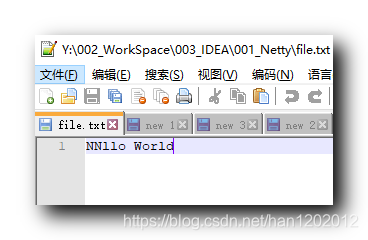【Netty】NIO 缓冲区 ( Buffer ) ( 缓冲区读写类型 | 只读缓冲区 | 映射字节缓冲区 )
I . 缓冲区 ( Buffer ) 存取类型
1 . 缓冲区 ( Buffer ) 数据读写类型 注意点 : 以 字节缓冲区 ( ByteBuffer ) 为例 ;
① 向 字节缓冲区 ( ByteBuffer ) 中放入数据 :
- 放入 Int 类型数据 : ByteBuffer putInt(int value) ;
- 放入 Double 类型数据 : ByteBuffer putDouble(double value) ;
- 放入 Short 类型数据 : ByteBuffer putShort(short value) ;
② 从 字节缓冲区 ( ByteBuffer ) 中读取数据 :
- 取出 Int 类型数据 : int getInt() ;
- 取出 Double 类型数据 : double getDouble() ;
- 取出 Short 类型数据 : short getShort() ;
③ 读取数据注意点 : 读取 字节缓冲区 ( ByteBuffer ) 数据时 , 必须按照放入 字节缓冲区 ( ByteBuffer ) 中的数据进行 , 否则就会读出错误数据 , 或乱码 ;
④ 读取溢出 : 读取 或 写出时 , position 一定不能超过 limit , 否则就会报 BufferUnderFlowException 异常 ;
Exception in thread "main" java.nio.BufferUnderflowException
at java.nio.Buffer.nextGetIndex(Buffer.java:506)
at java.nio.HeapByteBuffer.getInt(HeapByteBuffer.java:361)
at kim.hsl.nio.BufferDemo2.main(BufferDemo2.java:23)
- 1
- 2
- 3
- 4
代码示例 :
package kim.hsl.nio;
import java.nio.ByteBuffer;
public class BufferDemo2 {
public static void main(String[] args) {
//1 . 创建一个存储 Int 类型数据的 Buffer , 可以存储 1024 个字节
ByteBuffer buffer = ByteBuffer.allocate(1024);
//2 . 向缓冲区中放入数据
buffer.putInt(8888);
buffer.putDouble(88.888);
buffer.putShort((short) 888);
//3 . 写入转读取前先翻转, 将 position 设置为 0
buffer.flip();
//4 . 从缓冲区中读取数据
int intValue = buffer.getInt();
double doubleValue = buffer.getDouble();
short shortValue = buffer.getShort();
//已经读取完了, 在读取就溢出了 java.nio.BufferUnderflowException
//buffer.getInt();
//5 . 打印读取的数据信息
System.out.println(String.format("intValue = %d, doubleValue = %f, shortValue = %d",
intValue, doubleValue, shortValue));
}
}
- 1
- 2
- 3
- 4
- 5
- 6
- 7
- 8
- 9
- 10
- 11
- 12
- 13
- 14
- 15
- 16
- 17
- 18
- 19
- 20
- 21
- 22
- 23
- 24
- 25
- 26
- 27
- 28
- 29
执行结果 :
intValue = 8888, doubleValue = 88.888000, shortValue = 888
- 1
II . 只读缓冲区 ( ReadOnlyBuffer )
1 . 只读 缓冲区 ( ReadOnlyBuffer ) :
① 只读缓冲区 ( ReadOnlyBuffer ) 获取 : 先创建一个 Buffer 对象 , 向其中存储数据 , 调用 asReadOnlyBuffer() 方法 , 可以返回一个只读缓冲区 , 该缓冲区 , 只能读取 , 不能写入 ;
② 实际类型 : 只读缓冲区的类型是 HeapByteBufferR ;
③ 只读缓冲区写入数据异常 : 该 只读缓冲区 ( ReadOnlyBuffer ) 只能读取数据 , 不能向其中写入数据 ; 如果写入数据 , 就会报异常 ;
Exception in thread "main" java.nio.ReadOnlyBufferException
at java.nio.HeapByteBufferR.putShort(HeapByteBufferR.java:324)
at kim.hsl.nio.BufferDemo3.main(BufferDemo3.java:28)
- 1
- 2
- 3
2 . 示例代码 :
package kim.hsl.nio;
import java.nio.ByteBuffer;
public class BufferDemo3 {
public static void main(String[] args) {
//1 . 创建一个存储 Int 类型数据的 Buffer , 可以存储 1024 个字节
ByteBuffer buffer = ByteBuffer.allocate(1024);
//2 . 向缓冲区中放入数据
buffer.putInt(8888);
buffer.putDouble(88.888);
buffer.putShort((short) 888);
//3 . 写入转读取前先翻转, 将 position 设置为 0
buffer.flip();
//4 . 将上述缓冲区转为只读缓冲区
ByteBuffer readOnlyBuffer = buffer.asReadOnlyBuffer();
//5 . 从缓冲区中读取数据
int intValue = readOnlyBuffer.getInt();
double doubleValue = readOnlyBuffer.getDouble();
short shortValue = readOnlyBuffer.getShort();
//已经读取完了, 在读取就溢出了 java.nio.BufferUnderflowException
//buffer.getInt();
//向只读缓冲区中存放数据抛 java.nio.ReadOnlyBufferException 异常
//readOnlyBuffer.putShort((short) 888);
//5 . 打印读取的数据信息
System.out.println(String.format("intValue = %d, doubleValue = %f, shortValue = %d",
intValue, doubleValue, shortValue));
}
}
- 1
- 2
- 3
- 4
- 5
- 6
- 7
- 8
- 9
- 10
- 11
- 12
- 13
- 14
- 15
- 16
- 17
- 18
- 19
- 20
- 21
- 22
- 23
- 24
- 25
- 26
- 27
- 28
- 29
- 30
- 31
- 32
- 33
- 34
执行结果 :
intValue = 8888, doubleValue = 88.888000, shortValue = 888
- 1
III . 映射字节缓冲区 ( MappedByteBuffer )
1 . 映射字节缓冲区 ( MappedByteBuffer ) : 在内存中修改文件 , 不需要将文件中的内容拷贝到内存中 , 再修改后 , 写回到文件 , 其性能提高了很多 ;
① 内存说明 : 修改文件的内存并不是堆内存 , 而是在堆外内存中 ;
② MappedByteBuffer 类结构 :
- MappedByteBuffer 继承 ByteBuffer 抽象类 ;
- MappedByteBuffer 本身也是抽象类 , 其有两个子类 , 分别是 DirectByteBuffer , DirectByteBufferR ;
③ 可操作区域 : fc.map(FileChannel.MapMode.READ_WRITE, 0, 10); 的 MappedByteBuffer 只能操作 从 0 索引开始的 10 个字节 , 即从 0 到 9 索引代表的字节 , 其中的 10 代表可操作性的字节个数 , 并不是索引值 ;
2 . 代码示例 :
package kim.hsl.nio;
import java.io.IOException;
import java.io.RandomAccessFile;
import java.nio.MappedByteBuffer;
import java.nio.channels.FileChannel;
public class MappedByteBufferDemo {
public static void main(String[] args) {
RandomAccessFile randomAccessFile = null;
try {
randomAccessFile = new RandomAccessFile("file.txt", "rw");
FileChannel fc = randomAccessFile.getChannel();
//FileChannel.MapMode.READ_WRITE : 指的是读写模式
//0 : 将文件从 0 位置开始映射到内存中
//10 : 将文件从 0 位置开始映射到内存中的大小
//即 将 file.txt 文件从 0 开始的 10 字节映射到内存中
MappedByteBuffer mappedByteBuffer = fc.map(FileChannel.MapMode.READ_WRITE, 0, 10);
mappedByteBuffer.put(0, (byte) 'N');
mappedByteBuffer.put(1, (byte) 'N');
} catch (IOException e) {
e.printStackTrace();
} finally {
try {
if(randomAccessFile != null)
randomAccessFile.close();
} catch (IOException e) {
e.printStackTrace();
}
}
}
}
- 1
- 2
- 3
- 4
- 5
- 6
- 7
- 8
- 9
- 10
- 11
- 12
- 13
- 14
- 15
- 16
- 17
- 18
- 19
- 20
- 21
- 22
- 23
- 24
- 25
- 26
- 27
- 28
- 29
- 30
- 31
- 32
- 33
- 34
执行结果 : 在 IntelliJ IDEA 环境中打开没有刷新 , 在文件浏览器中打开 , “Hello World” 的前两位变成了 “NN” ;

文章来源: hanshuliang.blog.csdn.net,作者:韩曙亮,版权归原作者所有,如需转载,请联系作者。
原文链接:hanshuliang.blog.csdn.net/article/details/106364443
- 点赞
- 收藏
- 关注作者


评论(0)